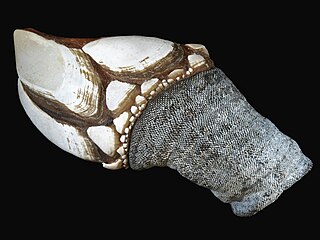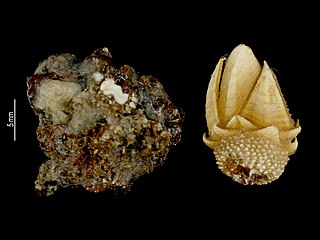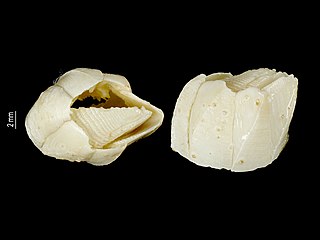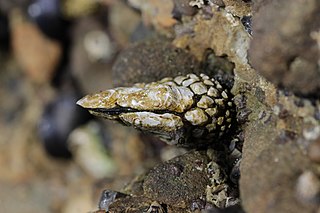Related Research Articles

Thecostraca is a class of marine invertebrates containing over 2,200 described species. Many species have planktonic larvae which become sessile or parasitic as adults.

The Balanidae comprise a family of barnacles of the order Balanomorpha. As a result of research published in 2021 by Chan et al., the members of the family Archaeobalanidae were merged with this family.

The Chthamalidae are a family of chthamaloid barnacles, living entirely in intertidal/subtidal habitats, characterized by a primary shell wall of eight, six, or four plates, lacking imbricating plate whorls, and either membraneous or more rarely calcareous basis. They are not found below immediate subtidal habitats, and more likely are found in the highest tier of shallow-water barnacle fauna. They can be found in the most rigorous wave-washed locations, and some species are found in the surf zone above high tide mark, only receiving water from wave action at high tide.

Pollicipedidae is a family of goose barnacles.
In the past, Lernaeodiscidae has been considered a family of barnacles. Research published in 2021 by Chan et al. resulted in the genera of Lernaeodiscidae being merged with that of Peltogastridae, which now contains the members of both families. As an exception, the species Triangulus galatheae was moved to the genus Paratriangulus in the family Triangulidae.

Lepadidae is a family of goose barnacles, erected by Charles Darwin in 1852. There are about five genera and more than 20 described species in Lepadidae.
In the past, Archaeobalanidae has been considered a family of barnacles of the order Sessilia. Research published in 2021 by Chan et al. resulted in the genera of Archaeobalanidae being merged with that of Balanidae, which now contains the members of both families. In the same work, Sessilia was not retained as an order of barnacles.

Elminiidae is a family of symmetrical sessile barnacles in the order Balanomorpha. There are about 5 genera and 12 described species in Elminiidae.

Calanticidae is a family of acorn barnacles in the order Calanticomorpha. There are about 12 genera and more than 60 described species in Calanticidae.
In the past, Notochthamalinae has been considered a subfamily of barnacles of the family Chthamalidae. Research published in 2021 by Chan et al. resulted in the genera of the three subfamilies Euraphiinae, Chthamalinae, and Notochthamalinae being assigned directly to the family, without subfamily groupings, and this subfamily is no longer used.
The Catophragmidae are a family of barnacles in the superfamily Chthamaloidea with eight shell wall plates, surrounded by several whorls of imbricating plates. The basis is membranous.

Heteralepadidae is a family of goose barnacles.
In the past, Platylepadidae has been considered a family of barnacles of the order Sessilia. Research published in 2021 by Chan et al. resulted in the genera of Platylepadidae being merged with that of Balanidae, except Stephanolepas which was moved to Chelonibiidae. In the same work, Sessilia was not retained as an order of barnacles.
Cryptophialidae is a family of Acrothoracican barnacles in the order Cryptophialida, the sole family of the order. There are at least 2 genera and more than 20 described species in Cryptophialidae. These barnacles burrow into calcareous rocks and structures, such as limestone, shells, or corals.
In the past, Microlepadidae has been considered a family of barnacles. Research published in 2021 by Chan et al. resulted in the genera of Microlepadidae being merged with that of Poecilasmatidae, which now contains the members of both families.

Pachylasmatidae is a family of symmetrical sessile barnacles in the order Balanomorpha. There are about 10 genera and at least 30 described species in Pachylasmatidae.
Eolepadidae is an extinct family of barnacles in the order Eolepadomorpha. There are 2 genera and about 12 described species in Eolepadidae.

Brachylepadidae is an extinct family of barnacles in the order Brachylepadomorpha, the sole family in the order. There are about 7 genera and more than 20 described species in Brachylepadidae.
Eolepadomorpha is an extinct order of barnacles in the class Thecostraca. There are 2 families and about 14 described species in Eolepadomorpha.

Pollicipedomorpha is an order of pedunculated barnacles in the class Thecostraca. There are 3 families and more than 30 described species in Pollicipedomorpha.
References
- ↑ Chan, Benny K. K.; Dreyer, Niklas; Gale, Andy S.; Glenner, Henrik; et al. (2021). "The evolutionary diversity of barnacles, with an updated classification of fossil and living forms". Zoological Journal of the Linnean Society. 193 (3): 789–846. doi: 10.1093/zoolinnean/zlaa160 . hdl: 11250/2990967 .